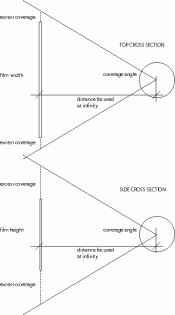Logan Group
Member
- Joined
- Nov 15, 2006
- Messages
- 41
- Format
- 4x5 Format
I'm trying to figure out what the widest lenses I can try to use on various ULF cameras. I know the minimums in term of coverage required per format but information regarding image circles is always given at infinity when the lens is closest to the film plane. Obviously if you focus on objects closer than infinity you increase the distance of the lens from the film plane, which also increases the image circle size.
Does anyone know of a mathematical formula (trig maybe?) to calculate the rate that an image circle will enlarge based on the distance of the lens from the film plane if you have a given knowledge of the image circle size at infinity, degree of coverage and of course focal length?
Does anyone know of a mathematical formula (trig maybe?) to calculate the rate that an image circle will enlarge based on the distance of the lens from the film plane if you have a given knowledge of the image circle size at infinity, degree of coverage and of course focal length?











